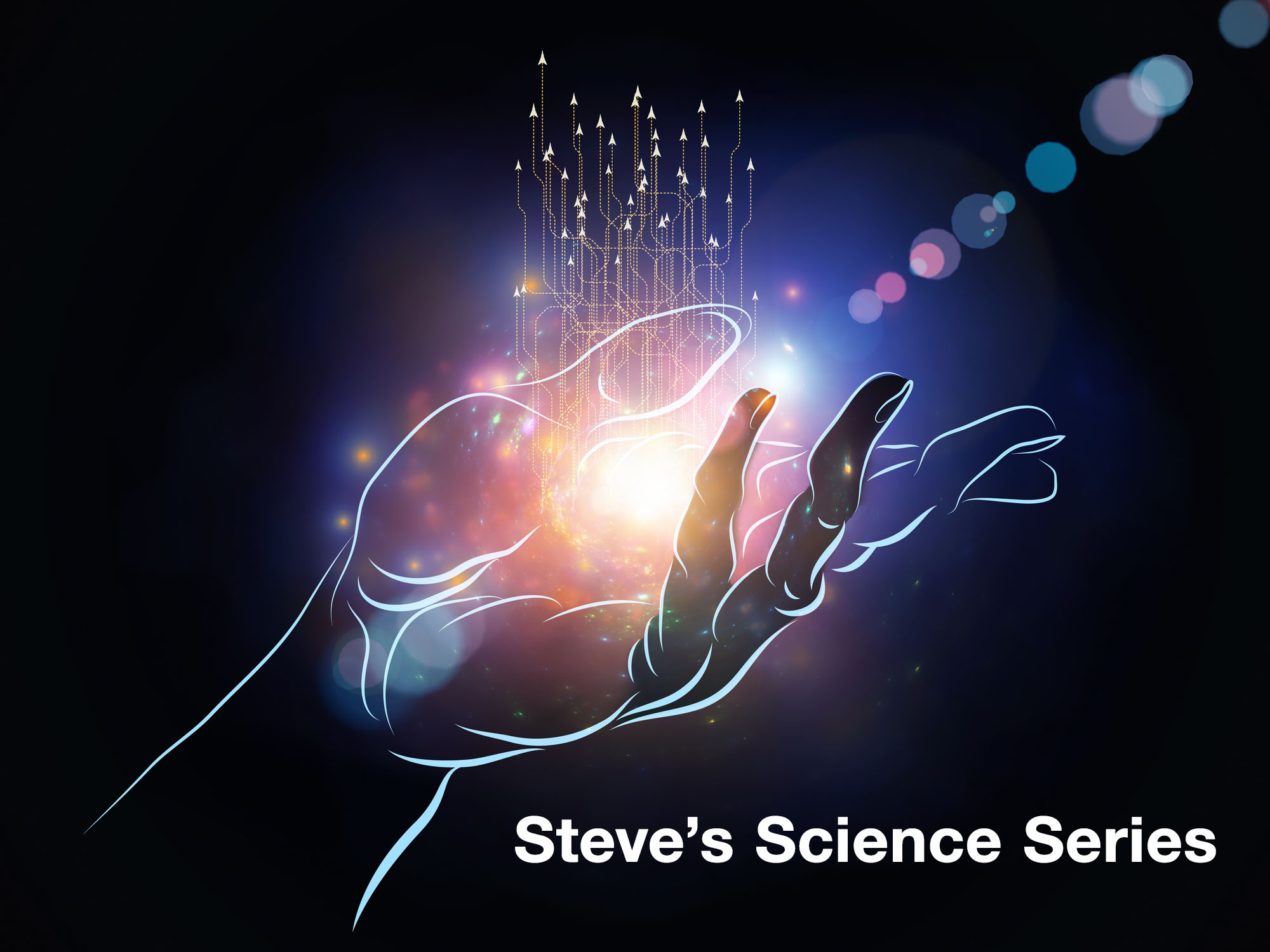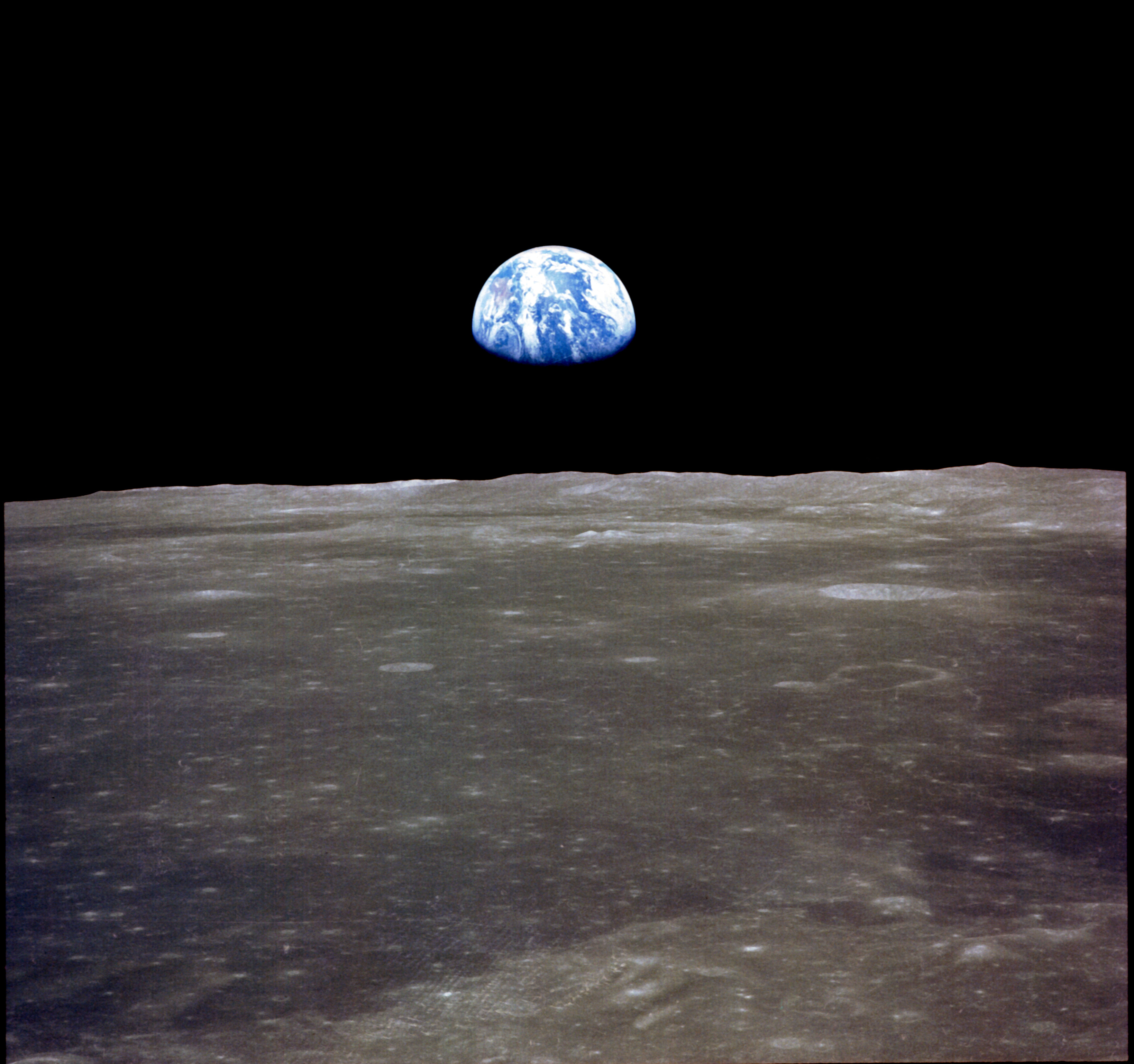Note: I had a beautiful version of this. Then I tried to move a picture, and lost it all. This is but a shadow of its former self.
Today marks the 50th anniversary of one of the greatest achievements of humanity, the landing of men on the Moon for the first time, July 20th, 1969.
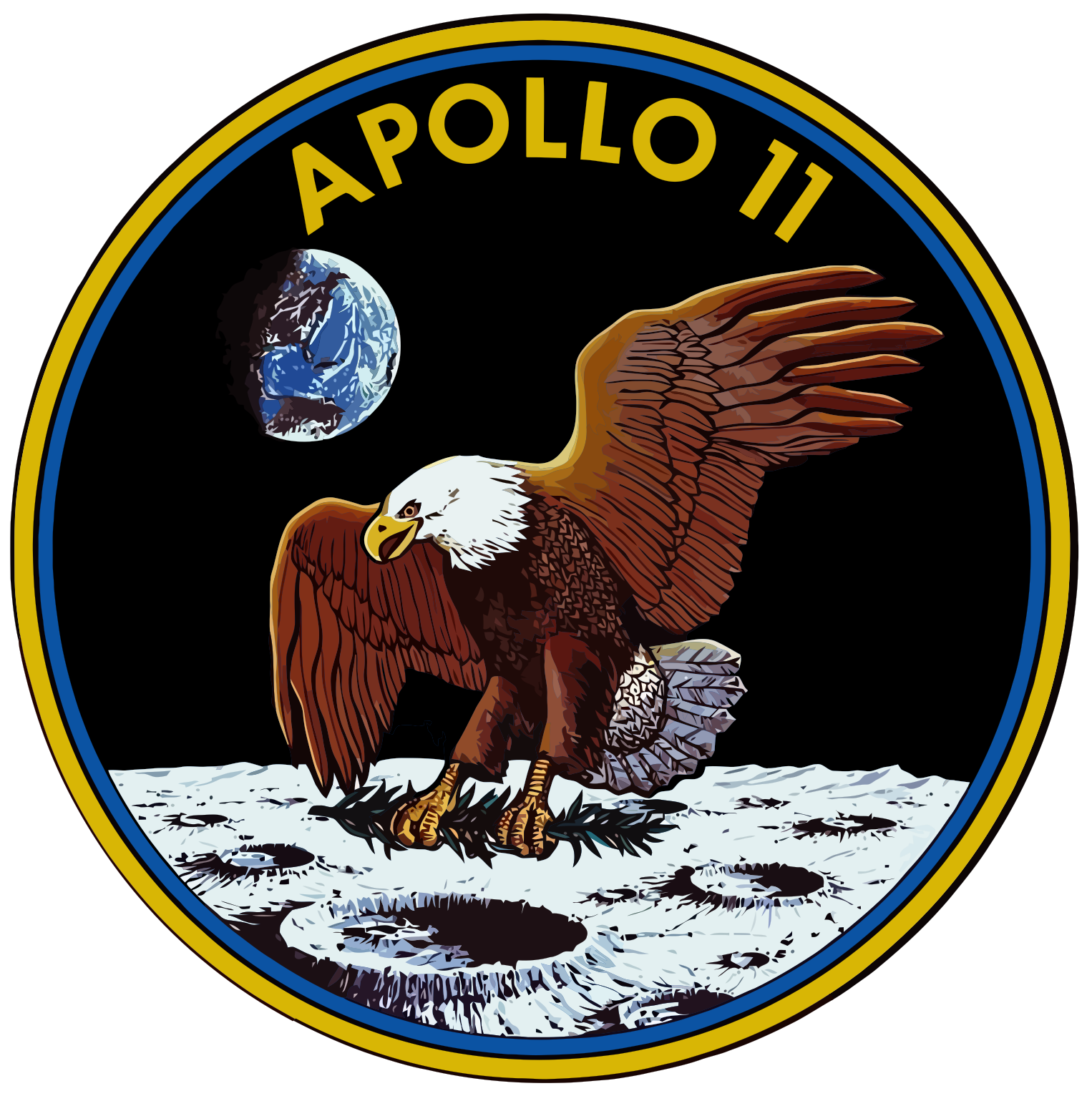
It was a long, long time coming. Technologically, we can trace it back to the first use of fire to smelt copper, or even further back to fire itself (see the back end of the Saturn V rocket), and stone tools.
Scientifically, it goes back to about 500 BCE, when people in a certain area of southeastern Europe we now call “Greece” began to think in a naturalistic way about the skies. Eclipses, both solar and lunar, were terrifying because they were unusual, they were thought to be bad omens; signals from the gods. But it had been noticed that solar eclipses could only happen at new moons, and lunar eclipses only at full moons. The Greeks, however, figured out why: a solar eclipse was due to the Moon passing directly between the observer and the Sun, while a lunar eclipse was the Moon passing through the Earth’s shadow. Furthermore, the Sun’s path against the stars—the Zodiac—was figured out with ease; the Moon’s path was harder to predict but did follow regular patterns. All you had to do was look forward to a situation where the Sun and Moon would be in the same place in the sky at the same time, and you knew there would be a solar eclipse; if the Moon would be perfectly opposite from the Sun, a lunar eclipse. (Note: these descriptions of geometry are as seen from Earth.) That took the mystery out of eclipses; they were totally predictable, and simply the result of regular movements of celestial bodies. It didn’t make sense to most people for eclipses to be omens if they could be predicted a hundred years in advance.
That began an over-two-thousand-year-long process of figuring out how things worked up there, and how big things were and how far apart they were. It was, for various reasons, far easier to figure out the sizes of the Earth and the Moon, and the distance to the Moon, than it was for the other planets and the Sun (we got our first good measurements of these things in the 1700s).
We knew, very roughly, sizes, distances, and shapes, but not the “how it works,” quite early in this timespan. But much of the real progress happened in the 1500s and 1600s. Copernicus put forward a new vision of a sun-centered universe, with the planets, including the Earth, which had not before been considered a planet, in orbit around the Sun, rather than everything going around the Earth in circular orbits. However, he still insisted that the orbits were circular, so the past two thousand years of observational data simply couldn’t be reconciled with his theory, any better than they could be with a simple geocentric model (but in the fullness of time, it would turn out he got the Big Idea right). Galileo saw things through the telescope that overthrew some of the dogmatism imposed on science by the Church (though the story is more complicated than that); but he still insisted on the circular orbits. The Jesuits knew (correctly) that that couldn’t be true. Galileo also did enough work in mechanics to lay the groundwork for Newton.

Galileo’s telescopes. He looked through these, and the world was never the same again.
But before Newton, we have to talk about Tycho Brahe and Johannes Kepler. Brahe made observations of the planets’ positions (as seen from Earth) of unprecedented accuracy; Kepler was able to use these to discover that we were observing planetary motion along elliptical orbits… from a planet following an orbit that was also elliptical! The ellipses all had the Sun at one focus, but they were of different sizes, shapes, had different orientations of their long axes, and were even tipped so they weren’t in the same plane. To top it off, the motion wasn’t at a constant speed either; it’d be slower at one end of the ellipse—the one furthest from the Sun—and faster at the other end. Kepler was able to figure out that if you drew a line from the Sun to a planet (or the Earth to its Moon), that line would sweep out equal areas in equal times… a thinner, longer slice farther away, a wider, shorter slice when the planet was nearer to the Sun.

He did this using nothing but the direction the planets appeared from Earth—no distances (he had to figure them out!)—and he did it without calculus, without a calculator, and without knowing the law of gravitation. And I would love to know how he did it.
Many, many years later he figured out a relationship between the size of the orbit, and the period—the time it took to complete an orbit. For Earth that’s almost (but not quite) one tropical year.
So now, between Copernicus, Galileo, and Kepler we had an accurate model of how the planets behaved. But we didn’t know why they did so, nor did we know how our own (prospective) spacecraft would behave “up there.”
Isaac Newton was the greatest scientist who ever lived. He put mechanics—the most basic branch of physics—on a firm footing, founded optics as a science, and figured out that the force that caused the planets to orbit the Sun, and the Moon to orbit the Earth, was the same force that makes things fall to the ground when you drop them. [That was a revelation. Up to then, things “up there” were believed to be fundamentally different from things “down here.”] And a spacecraft would be subject to the same forces. He could figure this out because he knew the distance to the Moon, and realized that if some force followed the inverse square law, it matched the behavior of the Moon in its orbit and the falling hammer. He also eventually proved that a force that followed such a law would cause things to move in elliptical orbits. He needed calculus to do this; unfortunately he didn’t have calculus. No one did, it didn’t exist. So he invented it. (Another person in Germany, Leibniz, was also inventing calculus at the time, but they didn’t know about each other’s work, so it’s effectively as if each of them invented it in full.)
At first, Newton didn’t publish this work; but someone else, trying to figure out what could make the planets move in ellipses, asked him, and he told them. “Can you show me the proof?” was basically the response. Newton had to go look for the papers. While the greatest minds in Europe were wondering what could make planets move in elliptical orbits… Newton had found the answer and—lost—it!
(If you get the idea that I admire Galileo, Kepler, and Newton, you’re damned right I do!)
Of course we now call that force “gravity.” Here is the law that governs it (except near extremely massive objects, as Einstein discovered).

If that looks complicated—it’s worse! It’s supposed to be a vector formula, with r and the two Fs as vectors.
At this point, we knew that to get to the Moon, we’d have to fight Earth’s gravity all the way, a quarter million miles or so, but that (at least) you could coast large parts of the way, much as the planets basically coast in their orbits around the Sun. We had some conception, finally, of what we’d have to do to make it happen. We ultimately learned we’d have to bring our own air with us, because our atmosphere didn’t extend to the Moon; and we’d have to solve a huge number of other problems as well, problems people in the 1600s couldn’t dream of. But from this point forward, we basically knew the size of the problem and in principle what we had to do; now it was “just” engineering; creating craft that could do those things, and keeping people alive on them in a very adverse environment.
It should be noted that Apollo 11 could not have succeeded if our basic understanding of the Earth-Moon system, and the force of gravity, were wrong. Claiming that our theory of gravity is wrong, or that the Earth and Moon aren’t spheres of the sizes they are, or that the distance is wrong, is logically equivalent to the claim that we’ve never gone into space, much less to the Moon, either manned or unmanned. If our theory is wrong, the things we’ve done based on it could not have been done.
So how was it done?
Our astronauts first had to be put in orbit around the Earth. This requires a rocket, a big one, because we have to go from moving about a thousand miles an hour relative to the Earth (we get that from the fact that the Earth is rotating on its axis) to moving at fifteen or sixteen thousand miles per hour, or roughly 7000 meters per second. The rocket has to get our astronauts, and their spacecraft, and their food and air, up above the atmosphere and moving at that speed, roughly horizontally. There are a couple of ways to convey how this works without getting technical. But it’s important to know they aren’t “beyond the reach of gravity” or anything like that. The Earth still pulls on them, they are still falling down, towards the Earth, but they are moving so far sideways in the same amount of time that the Earth, being spherical, has dropped away the same amount. Or you can look at it another way: the centrifugal force of moving around the Earth in such a big circle counterbalances gravity.
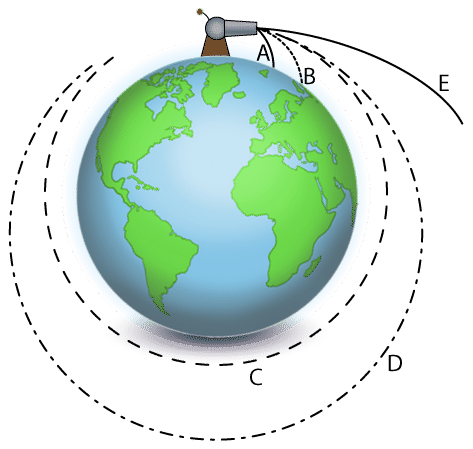
Newton used this concept of firing a cannon at higher and higher velocities to explain putting something into orbit.
The Saturn V—the billion horsepower wonder—the most powerful machine ever designed by man that wasn’t a big bomb—had three stages, all below the service module (cylindrical) and command module (conical). The astronauts lived in the command module; the service module supplied oxygen and included its own rocket motor for propulsion. The bottom two stages were jettisoned during the ascent, the third stage remained attached to the service module and command module in orbit.
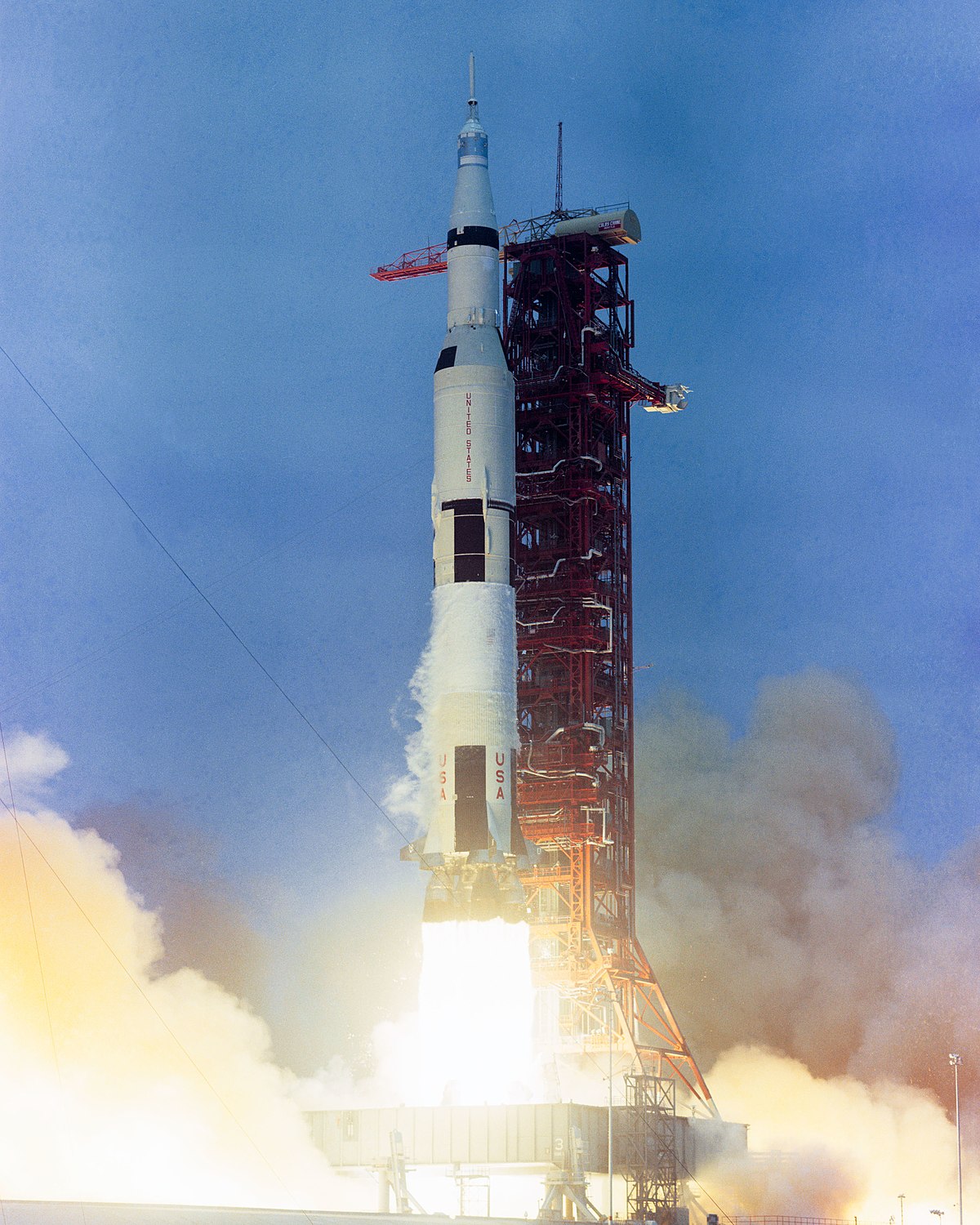
I’ll point out here that the reason the Saturn V rocket was so big was because it had to be able to put the service module, command module, and its own third stage, all into orbit at once. A heavy load like this required a heavy rocket.
So now that the Apollo astronauts were in orbit, the next step of the process was to wait until the right point in the spacecraft’s orbit around the Earth, and fire the rocket in the third stage. This added more speed to the spacecraft… which has the effect of raising the other end of the orbit, lengthening the eclipse. Eventually, the ellipse was long (or tall, depending on your point of view) enough to reach the Moon’s orbit.

It had to be aimed in the right direction when this happened, or it wouldn’t be headed toward the Moon.
This started about three days of coasting, with the Earth pulling back at Apollo 11 the whole time, gradually slowing it down as it climbed in its orbit. Remember what Kepler said about orbital speed?
One very important thing had to be done during this coast. The astronauts had to separate the command module and service module (together known as Columbia) from the Saturn V third stage, swivel around to face the third stage, and dock with the lunar module, the lander known as Eagle, which was stored in the third stage. They then had to pull the lander out of the third stage, and then continue on to the Moon without the stage.

The Eagle had to be stored in the third stage, below/behind Columbia, because if it had been put on top of the command module during launch, it would have been shredded by the Earth’s atmosphere. This was a complicated maneuver, and part of the Gemini program of the mid 1960s was learning how to dock spacecraft. It had a complicated name, too: it was called the transposition, docking, and extraction, and it was executed flawlessly by Michael Collins.
By the time Apollo 11 got near the Moon, it was traveling at a mere 1 mile per second. But, this was too fast! You see, Apollo 11 may have been near the Moon, but it was traveling faster than the Moon’s escape velocity. Without slowing down, it would just coast on by.
In fact, the third stage had also continued coasting after the extraction, and it was nearby. It would sail on past the Moon, getting a slingshot and escaping Earth entirely, going into its own orbit around the Sun. It’s still out there, somewhere.
So it was time for another “burn”, this time pointed in the direction of travel, to slow Apollo 11 down. This was done by firing the rocket motor in the service module. Once that was done, the astronauts were in orbit around the Moon! They waited about 30 orbits, then Armstrong and Aldrin moved into the lander, and detached from the command module.
All of this had been done before. Apollo 8 had orbited the Moon and returned, and Apollo 10 had actually almost landed on the Moon with its own “lander.” (Is it a lander if it never lands?)
But this time it was for real. A landing site had been picked, but there was much we did not know. One possibility was that the dust on the surface would be so deep it would swallow the spacecraft. (Though we had sent unmanned craft to the Moon earlier, and they had not got lost in deep dust, who knew if this part of the Moon was the same?) Also, we had never seen the landing site up close—it could be filled with boulders instead of being flat.
As it turned out, the landing site was treacherous, and Neil Armstrong had to burn more and more fuel, looking for a good place to land. He barely found one before he would have had to abort, and return to the command module. That was why the mission controllers were almost blue in the face. Armstrong had just played “chicken” with the Moon, and won.
“Tranquility Base. The Eagle has Landed.” Men were on the Moon.
Men were on the Moon!
Think about that. We have existed as a species for something on the order of 200,000 years. And for 199,950 of those years, we had never been on the Moon.
(I was five when this happened. I don’t remember it, though I do remember Apollo 12. This is the one thing… the one thing… that sometimes makes me wish I were just a little bit older.)
Six and a half hours after landing, Neil Armstrong set foot on the Moon, soon to be joined by “Buzz” Aldrin.
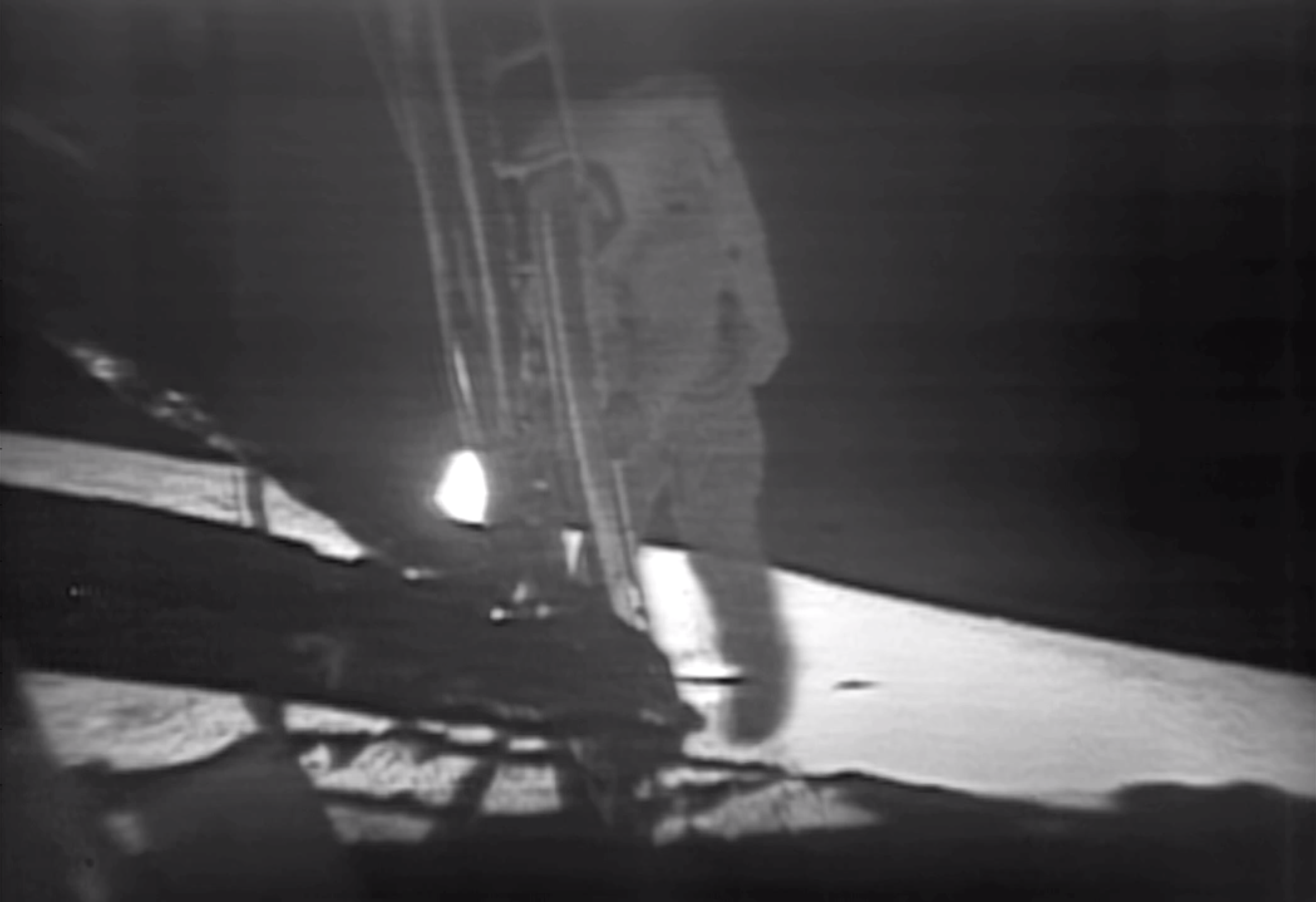
President Nixon called them while they were setting up the flag—which was difficult. Far from being deep dust there, just below surface it was rock-hard and they couldn’t plant the pole. Nixon said:
Hello, Neil and Buzz. I’m talking to you by telephone from the Oval Room at the White House. And this certainly has to be the most historic telephone call ever made. I just can’t tell you how proud we all are of what you’ve done. For every American, this has to be the proudest day of our lives. And for people all over the world, I am sure they too join with Americans in recognizing what an immense feat this is. Because of what you have done, the heavens have become a part of man’s world. And as you talk to us from the Sea of Tranquility, it inspires us to redouble our efforts to bring peace and tranquility to Earth. For one priceless moment in the whole history of man, all the people on this Earth are truly one: one in their pride in what you have done, and one in our prayers that you will return safely to Earth.
One line bears repeating.
Because of what you have done, the heavens have become a part of man’s world.
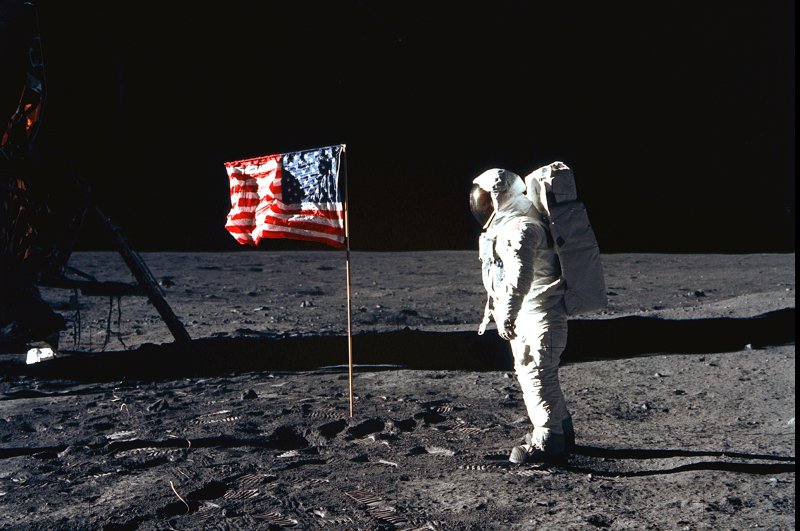
Soon enough, it was time to return. The top half of the lander, known as the ascent stage, blasted off, using the lower part of the lander as a launch pad. It had to rendezvous in orbit with Columbia, requiring exact timing on the launch (or it would reach orbit and Columbia would be somewhere else), and another docking maneuver. Then, with Armstrong and Aldrin back in Columbia the ascent stage was jettisoned. Columbia then did a burn to escape from lunar orbit, heading back to Earth.
The trickiest part was yet to come. On return to Earth, there was simply no fuel left in the service module. The two big burns near the Moon, plus minor corrections, had used up everything. The craft couldn’t do another burn to go into orbit and then another to gracefully descend—there wasn’t enough fuel. Even the Saturn V didn’t have the capacity to send that much fuel to the Moon and back. Instead, the service module, too, was abandoned, once it put the command module on a precise trajectory. The command module had to be aimed at the Earth’s atmosphere at a very precise angle, one which would allow it to aerobrake. Too shallow and it would basically bounce off the atmosphere, too steep, and it becomes a meteor.
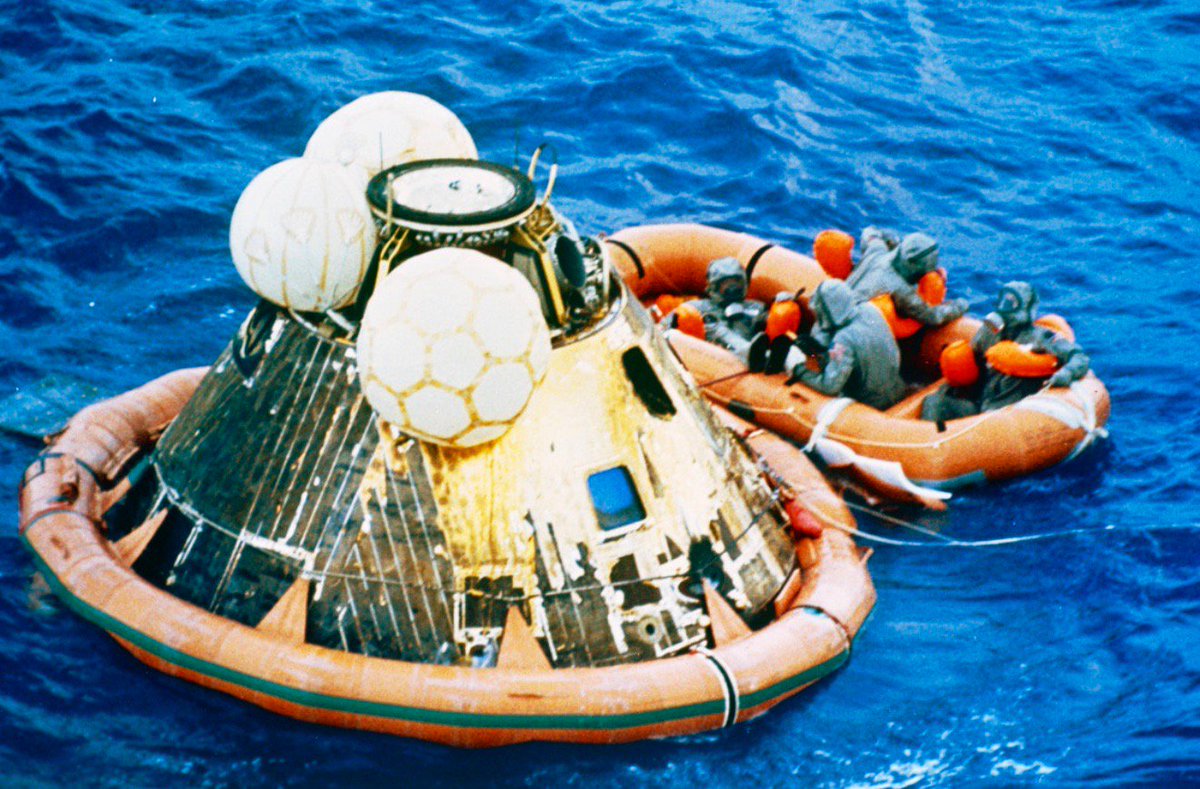
And return them safely to Earth…
The entire gigantic pile of explosives known as Saturn V had been needed to send the command module to the Moon and bring it back to Earth, could not do an aerobrake because there was no fuel left. It was only made possible by using a light tin can of a lander and abandoning everything once it was no longer needed. Each abandoned piece was responsible for carrying the weight of the remaining part of the mission; if you think about that, that necessitates big pieces at the beginning, small ones at the end.
So what did I mean by subtitling this, “A Triumph of Man Living In Freedom”?
This whole thing was made possible by man’s mind, his rational thought processes, his reason.
None of this could have happened, without minds free to think, free to reason. We’d never have understood what needed to be done.
None of this could have happened, without people free to build prosperous lives, to learn practical skills, or we’d never have had the resources nor the technical skills to do it.
Only FREE people could do these things. The Soviets came close… but they were piggybacking on the free world; they couldn’t have done it without free people, past and present.
And only FREE people can make any sort of progress, produce wealth which enhances our lives, allows us to thrive rather than just existing.
Don’t let them take it away from us. If they do, we lose not just what took us to the Moon, we lose what we could do in the future. Worse, we also lose what makes it possible to thrive here on Earth.
Don’t let them take it away from us.
Don’t let them.
Don’t.
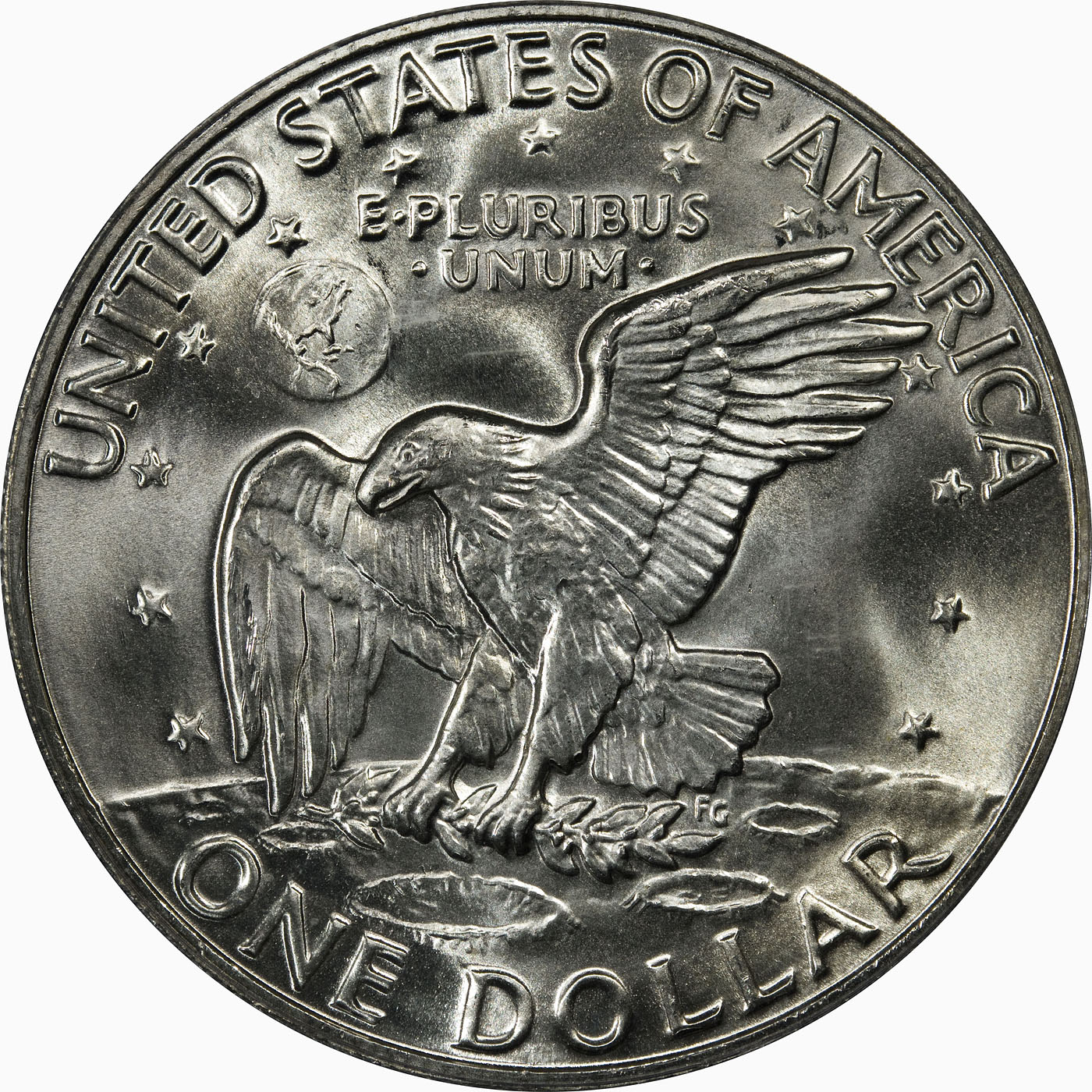
Did you honestly think I’d do a post and not include a coin picture?
Of course, I didn’t do a coin picture on July 4th. Luckily, I have another one to show you to make up for it.

Sort of fits with my subtitle better, no?


